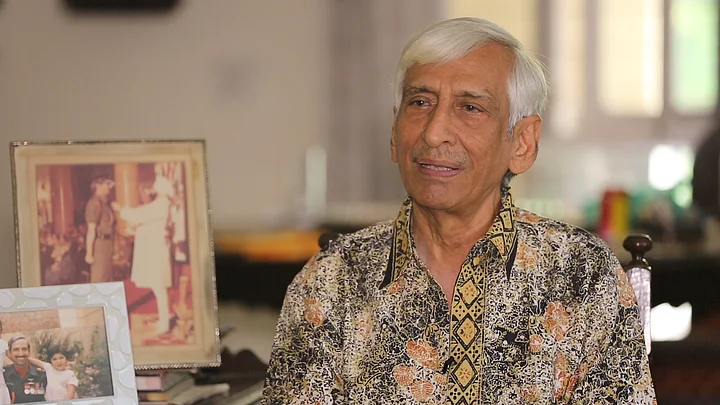Thirty-five years ago on this day, the Golden Temple was besieged by the Indian Army under then-prime minister Indira Gandhi’s orders to evict and neutralise Khalistani militants led by Jarnail Singh Bhindrawale. One of the military commanders, Brigadier (retired) Israr Rahim Khan recounted the siege for The Quint last year.
A day after curfew descended on the Sikh holy city of Amritsar on 1 June 1984, a young Sikh army Captain Jasbir Singh Raina, dressed in the traditional Punjabi kurta-pajama, entered the Golden Temple. He was just one among a couple of thousand devotees and pilgrims feigning paying obeisance at Harmandir Sahib that day.
He was on a risky undercover mission: to spy on the presence of heavily armed terrorists who had laid siege to the Golden Temple – when there was little by way of intelligence on the extremists’ capabilities and their specific holdouts within the sprawling complex that is the spiritual centre of Sikhism.
Patchy Intelligence
“There was only patchy intelligence from the civilian security agencies. So, once Prime Minister Indira Gandhi issued the order that set in motion a bold and audacious plan of action and Major General Kuldeep Singh ‘Bulbul’ Brar selected me to lead Operation Bluestar, I sent in Captain Raina,” recalls Brigadier (retired) Israr Rahim Khan, then a Lieutenant Colonel commanding the 10th Guards regiment.
“Captain Raina was followed by gun-wielding extremists wherever he went inside the temple complex. Once he left the temple, his debriefing did not yield much information, save some valuable information on a few of the visible gun positions of the terrorists. Of course, he had no way to find out where Jarnail Singh Bhindrawale and his well-trained comrades were hiding,” Khan says, 31 years after he led the attack into the Golden Temple, the Sikh equivalent of the Vatican that scarred not just the shrine but the psyche of generations of Sikhs.
‘Bhindrawale Turned Temple Into a Fortress’
The ornate and majestic temple had been transformed by Bhindrawale and his followers into a heavily-armed and strategically defended fortress. Brick and mortar defences, reinforced by sandbags, had been put up. And within the labyrinth of tunnels and rooms in the three floors of the temple, the terrorists had made all preparations for gun battle from which they as well as Khan’s battalion knew there would be very few survivors.
10:30 pm on 5 June was what, in the army’s parlance, was “HR”, the hour when Khan and a small detachment of the battalion he commanded “crossed the start line” barefoot. Three tanks and two Russian BMPs or armoured vehicles trundled up to the Darshan Deori in the northern wing of the temple complex. “Even before we entered through the Darshan Deori, we were under heavy fire from every road, lane, every gullee and every window,” Khan recalled as he fidgeted with the antiquated Rolex dangling at his left wrist.
‘Power Supply Had to be Cut’
It was pitch dark (since power supply in Amritsar had been cut) when the soldiers stormed in. Once inside the complex, the soldiers, armed with small arms – LMGs, rifles, carbines and hand grenades – found themselves vulnerable in the face of a volley of fire from the “loopholes” along the warren of rooms on the western and eastern flanks of the Parikrama. “The loopholes had been converted into weapons pits. The fire came at low height, injuring my boys below their knees as they tumbled,” Khan remembers.
It took a while before Khan, pistol in hand, led his troops up the stairs of the Parikrama, hurling grenades inside the dark recesses from where they could see guns spewing rapid fire. “It took almost an hour before the heavily fortified rooms along the Parikrama could be cleared. But my objective was to take the Akal Takht where the terrorists were concentrated,” Khan says excitably.
‘Unique, Extraordinary and Fierce Battle’
By the time Khan reached the Akal Takht, he was “grouped with a company of troops from the 1 Para Commando and another company of the Special Frontier Force, a special ops unit of the RAW. As the gunfight intensified, the army opened up with mortars. “The marble floors of the three-storied Akal Takht had been dug up to create layers from where the terrorists fired at us. We moved up floor by floor and secured all of them by 2:30,” Khan recalls of the “unique, extraordinary and fierce battle.”
When first light broke on June 6, the tanks moved in with their machine guns firing. But this hardly had any effect on the solid structure of the Akal Takht. “That is when the decision to use the tanks’ main guns was taken. The first shell blew a gaping hole in the golden dome and subsequent salvoes silenced the terrorists’ guns. Later, after isolated pockets of resistance were overcome, we found buried in the debris the bodies of Bhindrawale and his commander-in-chief, retired army Major General Shahbeg Singh, who had thrown in his lot with the extremists,” Khan says. The 10th Guards lost 19 men while 51 were grievously injured.
Collateral Damage
Khan admits that several of the pilgrims fell as “collateral damage” and that the operation could have been swiftly brought to an end if troops had moved in simultaneously from the southern wing of the temple. “The soldiers were stuck there because of a massive ironed gate. A tank had to be brought in to crush the gate before the soldiers could enter and end the resistance there,” Khan says.
“There are no cobwebs in my mind and I believe that it was a justified order on the part of the government,” the Kirti Chakra awardee beams, his light grey eyes gleaming. At that time Khan had no idea that Operation Bluestar would culminate first in Indira Gandhi’s assassination and then a prolonged period of death and destruction across Punjab.
(At The Quint, we question everything. Play an active role in shaping our journalism by becoming a member today.)
